Technical Diving: Redundant Computers vs Backup Bottom Timer & Custom Tables
Beginner technical divers often consider the merits of using redundant computers over a backup bottom time and tables. Whilst the cost differences are clear, it can be difficult to know the practical advantages and disadvantages of each option.
Technical diving involves a higher level of risk and complexity than recreational diving, with dives that exceed traditional recreational limits in-depth, time, and complexity. With the increasing use of technology, dive computers have become an essential tool for technical divers, providing real-time information about depth, time, and decompression status.
However, relying solely on a single device is not enough when the stakes are high, and redundancy is a critical principle in technical diving. In this article, I will explore the option of redundant computers in technical diving, the principles of redundancy, and the advantages and disadvantages of using a backup dive computer versus a backup bottom timer and custom tables.
The importance of dive computers in technical diving
Technical diving is a highly specialized form of scuba diving that requires extensive training, experience, and equipment. One of the most critical pieces of equipment used by technical divers is the dive computer.
Dive computers in technical diving
Dive computers are crucial in technical diving because they help divers track their dive profile and stay within the limits of their prepared decompression plan.
In technical diving, divers often use multiple dive computers, with one computer serving as a primary device and the other as a redundant backup. This redundancy ensures that if one computer fails or malfunctions, the diver still has critical information to rely on.
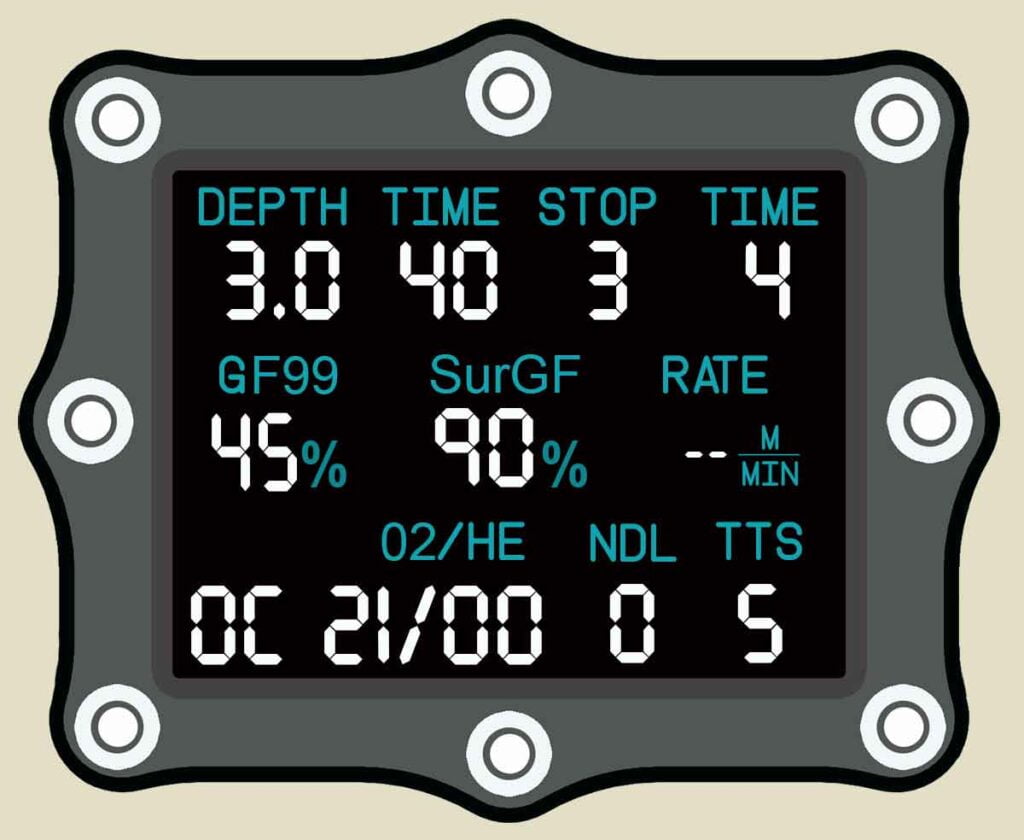
Early technical diving computers
Historically, a majority of technical divers used ‘pre-cut’ custom tables to manage their dives. These custom tables would be produced on a laptop or desktop PC using specialist technical dive planning software. During the dive, technical divers only needed a simple bottom timer and depth gauge to follow the pre-planned schedule.
Until the early-2000s, the dive computers that were available to technical divers were very expensive. Furthermore, they were also very inflexible and provided little capacity for the diver to ideally shape their ascent profile.
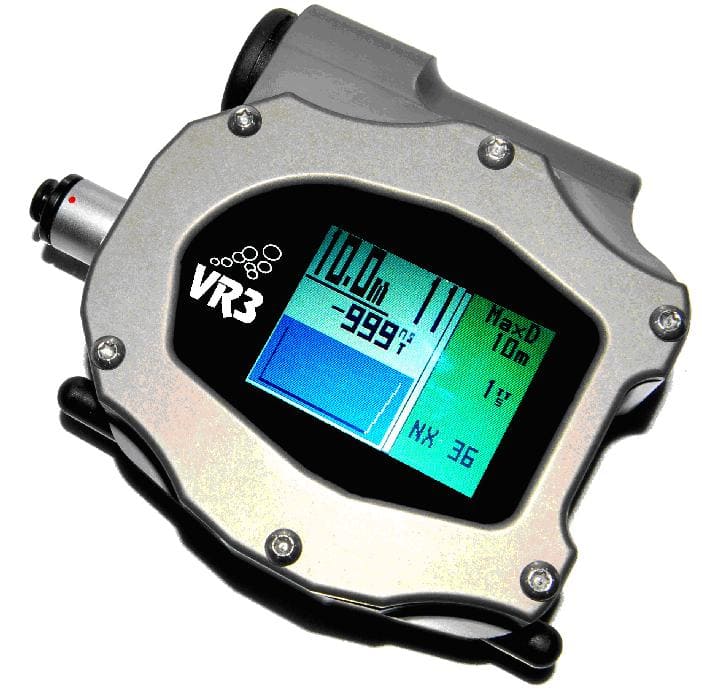
Those computers had a tendency to ‘lock out’ if the diver did not follow their specified ascent schedule exactly. In turn, this forced many divers to resort to using backup tables whenever a situation arose when the designated schedule could not be followed.
As a result, any discrepancy in the ascent profile would force the technical diver to use their backup. If the diver used redundant computers, both would be locked out for the same reason. For that reason, backup tables were the only practical solution.
Unsurprisingly, given these shenanigans, many technical divers chose to just use custom dive tables and bottom timers. Early technical diving computers offered little in the way of advantage considering their cost.
Modern technical diving computers
Over the last two decades, the capabilities of technical diving computers have developed enormously. For a start, no decent technical diving computer will ‘lock out’ the diver during a dive. Instead, they will continually re-calculate the best possible ascent schedule to surface the diver with the least DCS risk. This feature enables redundant computers to be a realistic solution for backup.
Secondly, modern technical diving computers typically offer a range of different algorithms. Alternatively, they will have features that enable the diver to customize the parameters of the algorithm. For instance, user-definable gradient factors. As a result, computers from different manufacturers can easily reproduce the same ascent profiles.
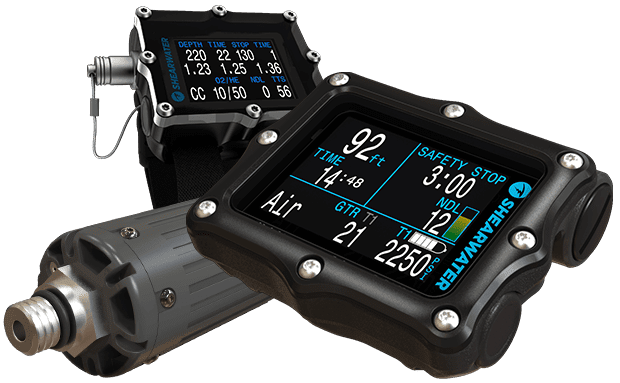
Modern technical diving computers are also far more affordable and accessible. Dive computer manufacturers like Shearwater, Ratio, Divesoft, Apeks, O’Dive, and Heinrichs Weikamp, offer very capable instruments at reasonable prices.
For these reasons, the vast majority of technical divers now use dive computers as their primary means of managing decompression schedules on their dives.
The advantages of a technical diving computer versus a pre-planned decompression schedule
Technical diving computers have a number of advantages over custom dive tables. In contrast, the only tangible benefit of using pre-cut tables and a bottom timer is equipment cost-saving.
For the extra money spent, a technical diving computer provides the following benefits:
- The decompression schedule is responsive to changes in the dive profile in real time
- The diver has the quickest feasible decompression ascent in the event of an emergency arising
- Additional conservatism can be added in real-time when circumstances dictate it is prudent
- The diver has access to additional decision-making information during their dive, such as real-time tissue gradients, surfacing gradients, and tissue compartment loading
- The ability to add or remove gasses from the decompression plan as the need or opportunity arises
Redundancy in technical diving
The increased risks of technical diving demand additional safety measures, including redundancy in equipment. The redundancy principle in technical diving involves having backup equipment to ensure the safety of the diver in case of equipment failure.
The redundancy principle in technical diving
Redundancy in technical diving equipment means that there are multiple options available for the diver in case of a malfunction. The mitigates foreseeable risks by ensuring that everything the technical diver relies upon is fail-safe.
A key difference between technical and recreational diving is that tech divers assume failures will occur. They plan and equip themselves with that assumption in mind. Unlike recreational divers, technical dives do not allow immediate surfacing when something goes wrong. The technical diver has to complete their planned decompression stops to avoid serious injury from DCS.
Another key difference is that technical divers have to be self-reliant. Whilst recreational divers may rely on the buddy system to provide failure redundancy, technical divers are expected to manage failures without complete reliance on their team.
As a result, technical divers use calculated redundancy for equipment critical to safely completing their dives, such as:
- Alternate gas sources
- Regulators
- Dive computers
- Cutting tools
- DSMBs and reels
- Masks
By carrying more equipment than recreational divers, technical divers can solve problems at depth and ensure their safety in case of equipment failure.
Technical diving redundancy is more sophisticated than having two of everything
However, the principle of redundancy is more sophisticated than simply having two of everything. Technical divers have to balance the utility of backup equipment against the drawbacks of increased task loading and reduced streamlining. Put simply, carrying more gear makes dives more complex and demanding.
As a result, a technical diver has to intelligently reason what specific dive gear is critical to their life support and ability to safely complete their dive.
Ultimately, the decision for redundancy is dictated by the consequences of a failure occurring. If a failure does not directly jeopardize the diver’s safety or ability to accurately complete their ascent plan, then redundancy may be considered superfluous.
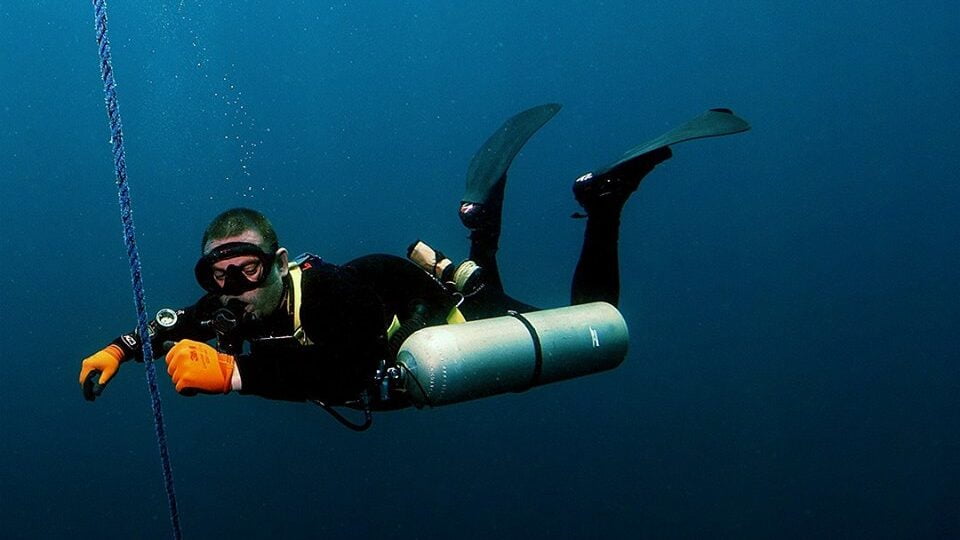
Other backup equipment in technical diving
The redundancy principle is an essential concept in technical diving, as backup equipment can mean the difference between a safe dive and a dangerous situation. In addition to having backup equipment, technical divers use specific equipment configurations that ensure they can ascend to the surface safely in case of a BCD failure.
The Balanced Rig principle is one such configuration that ensures the entire equipment configuration can support the diver in case of a BCD failure without requiring additional equipment, specific training, or complex emergency procedures.
Redundant gas sources are also critical in technical diving. Some popular configurations include back-mounted doubles with a manifold, which provides divers with two separate air sources that can be isolated in case of a malfunction.
Another popular modern option for gas redundancy is sidemount equipment. Similarly, technical rebreather (CCR) divers will have bail-out cylinders in case their rebreather fails. Or they may even have a backup rebreather.
The concept of redundancy is not unique to technical diving and is widely used in engineering to increase system reliability and improve performance. However, in technical diving, the redundancy principle is crucial to ensure the safety of divers exploring more challenging and hazardous environments.
Consequences of dive computer failure during a technical dive
A dive computer failure during a technical dive can have severe safety consequences. Without the accurate data and directions provided by dive computers, it becomes difficult for technical divers to:
- Maintain a safe ascent rate
- Know their depth
- Track the time of decompression stops
- Follow the necessary ascent profile
In turn, that deficit of information will cause an inaccurate ascent profile that creates an unreasonable risk of severe decompression sickness.
Redundant computers versus a single dive computer with a backup timer
Technical divers often use redundant computers during their dives, which might seem redundant at first glance. However, using redundant dive computers provides a level of safety that cannot be matched by a single computer, even with a backup timer.
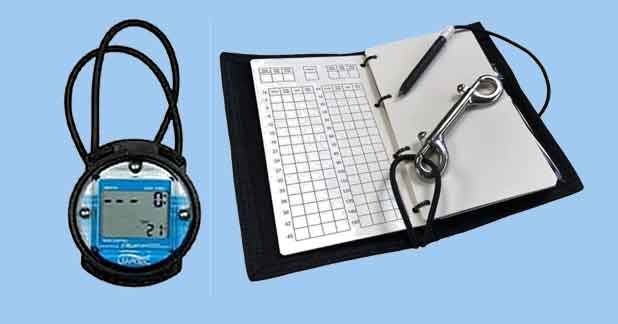
Here are some advantages of using redundant computers in technical diving:
Advantages of using redundant computers in technical diving
- Increased safety: Redundant computers provide a failsafe backup in case one of them fails, ensuring the technical diver has accurate and reliable data throughout the dive.
- Dive planning flexibility: Redundant computers allow for more accurate and precise dive planning, compared to a dive table backup. Ultimately, a single computer is limited by the parameters of a backup table plan.
- Real-time monitoring: By using redundant computers, divers can monitor either computer in real time. For instance, if one hand is busy performing a valve shutdown procedure, the technical diver can monitor critical information by having the backup computer on the other arm.
The Time To Surface (TTS) limit, backup tables, and delayed ascents
A single computer with a backup timer requires the diver to stay within the Time To Surface (TTS) of the pre-cut dive plan. If they exceed that limit on their computer, the backup plan becomes irrelevant.
Whilst technical divers who use tables as a backup usually create ‘just longer’ contingency plans, these usually just provide for a worst-case scenario. As such, they typically extend the decompression ascent by a significant amount of time. In doing so, they invariably require the consumption of reserve gas.
A momentary delay at the bottom can necessitate a substantial increase in ascent time. This reduces the flexibility of the team to deal with other emergencies that arise. For instance, if reserve gas is utilized to extend contingency decompression, that gas will not be available for donation if a team member suffers a deco regulator failure.
For that reason, using a single dive computer doesn’t enable more flexibility because the diver is ultimately constrained by their backup plan/s. In contrast, using redundant computers means that the backup adapts simultaneously and identically to match the current plan on the primary computer.
A short delay in ascent only necessitates a proportionally short extension in decompression time. That may be unideal, but it does not constitute a worst-case scenario.
Decompression schedules and early ascents
Additionally, pre-planned ascent schedules are not responsive to premature ascents. For instance, if the divers abort the dive due to an emergency arising.
Additionally, it is unlikely that a computer will fail exactly when the diver begins their ascent. The likelihood is that failures will occur during descent or bottom time. When that happens, the diver will not have incurred the full decompression penalty assumed by their dive plan. They would have far less deco obligation than a backup table would mandate.
In this case, after a computer failure, divers using backup tables would still have to complete the full decompression schedule. Obviously, that full decompression plan would be unnecessary if the bottom time was shorter than anticipated. Delaying the time to surface can have profound implications when dealing with an emergency underwater.
Using redundant computers enables technical divers with the flexibility to prematurely end their dive without being constrained by having to complete unnecessary decompression.
Disadvantages of using redundant computers in technical diving
Using redundant computers is not without disadvantages. These should be considered when making a decision on what is the best solution for you.
- Cost: Technical diving computers are expensive. Obviously, two computers are far more expensive than one computer and a bottom timer.
- Simultaneous failure: Technical diving computer ‘failures’ can result from human operator error. For instance, descending with the wrong gas mix enabled on the computer. This would lead to a perfectly functional computer not being able to accurately track inert-gas loading. In turn, any decompression schedule produced would be flawed. If that mistake were made with both computers, the diver would have no backup options.
- Does not avoid pre-dive planning: The technical diver needs to conduct diligent pre-dive planning regardless of having two computers to manage their dive. This is because they need to account for gas management and consider the parameters of various contingency scenarios. Even if that planning is not carried as a backup during the dive, on a slate or in wetnotes, it is nonetheless an important safety process.
For these reasons, a backup technical diving computer should not be perceived as a convenience. Likewise, there are factors that introduce risk. Using a backup computer for technical diving can:
- Stimulate complacency
- Increase the chance of human error
- Provoke neglect during dive planning
Redundant computers and diver traits
As a technical diver, you should be self-aware of your innate strengths and weaknesses. It is prudent to consider whether you are by nature predisposed to following protocols with discipline. Or, are you prone to complacency and the temptation to take shortcuts?
Using redundant computers is best for technical divers who have a high degree of trait conscientiousness. In contrast, using custom backup tables provides a clear structure to follow if you are prone to:
- Avoiding planning ahead
- Have difficulty pursuing long-term goals
- Are easily distracted
- Tend to follow your impulses
- Struggle with self-discipline in general
You don’t need to be highly contentious to be a technical diver. However, if that trait isn’t one of your strengths, you should establish systems that compensate for it. The choice between a redundant computer and using backup tables could be one of those systems.
Factors to consider with a redundant computers setup
Using redundant computers for technical diving demands certain consistencies between the computers used. This ensures that the data provided by each computer is consistent and reliable. Some common factors to consider include:
- Decompression modeling: Both redundant computers should use the same decompression model to ensure consistent and accurate data. The most popular contemporary algorithm for technical diving is Buhlmann ZHL-16C with gradient factor control. Backing up a Buhlmann algorithm computer with one that utilized VPM-B or RGBM would not be suitable. This is because the different algorithms would produce very different decompression schedules.
- User-programmed Gradient Factors: Technical diving computers using the Buhlmann algorithm usually allow custom gradient factors to be set. This allows both computers to be programmed to the same gradient parameters. In turn, this ensures both computers will output the same ascent profile.
- User interface: Dual technical diving computer setups often feature similar user interfaces, making it easier for divers to use and interpret the data provided by each computer. The menu steps for gas switching are particularly important, as both computers need to be changed quickly once a gas switch is performed.
Using redundant computers for technical diving
In conclusion, technical diving requires specialized equipment to ensure the safety of the divers. Dive computers are an essential tool for technical divers, providing accurate and real-time information about the dive, including depth, time, and decompression requirements. However, in the event of a malfunction, redundancy is crucial. Technical divers have several options for backup equipment, including backup tables and bottom timers, or redundant computers.
Using two dive computers is an effective redundancy strategy in technical diving. This approach ensures that if one computer fails, the diver still has a backup computer to rely on. However, it’s important to note that relying solely on dive computers, even redundant ones, can be risky. Technical divers should also consider carrying backup tables and timers as an ultimate fail-safe measure in case of computer failure.
Ultimately, the choice of equipment for redundancy in technical diving comes down to personal preference and diving experience. It’s important to understand the advantages and disadvantages of each option and choose the one that works best for each individual’s diving style.
Key points about redundant computers for technical diving:
- Technical diving computers are the modern norm for technical divers to manage their dives
- Redundancy is crucial in technical diving to mitigate foreseeable equipment failure risks
- Backup instrument options include custom tables and a bottom timer or dive computer redundancy
- Using two dive computers is an effective redundancy strategy in technical diving
- Relying solely on dive computers can be risky, and backup tables and timers should be considered as a fail-safe measure
- Reasoned risk consequence analysis should guide the choice of redundancy equipment in technical diving
About The Author

Andy Davis is a RAID, PADI TecRec, ANDI, BSAC, and SSI-qualified independent technical diving instructor who specializes in teaching sidemount, trimix, and advanced wreck diving courses.
Currently residing in Subic Bay, Philippines; he has amassed more than 10,000 open-circuit and CCR dives over three decades of challenging diving across the globe.
Andy has published numerous diving magazine articles and designed advanced certification courses for several dive training agencies, He regularly tests and reviews new dive gear for scuba equipment manufacturers. Andy is currently writing a series of advanced diving books and creating a range of tech diving clothing and accessories.
Prior to becoming a professional technical diving educator in 2006, Andy was a commissioned officer in the Royal Air Force and has served in Iraq, Afghanistan, Belize, and Cyprus.
In 2023, Andy was named in the “Who’s Who of Sidemount” list by GUE InDepth Magazine.
Purchase my exclusive diving ebooks!
The principle of redundancy is used in technical diving to ensure that the diver is fail safe in the event of critical equipment failures. These include life-support gear, such as the gas supply, and items needed to conduct the planned deco ascent, such as their mask and dive computer.
Technical divers use two computers as a fail-safe backup to mitigate the risk of dive computer failure. A technical diver must know their depth, time, ascent speed and the necessary decompression stops to ascend safely. This lowers the risk of DCS.
Technical divers produce custom decompression tables using laptop or desktop dive planning software. These tables provide the decompression stop schedule for a given dive.
Technical dive planning is typically done using dedicated computer software, such as Multideco or V-Planner. This calculates their decompression stops for a given dive, and produces contingency ascent plans should deviations from the plan occur.
Technical divers require redundancy for computer failure. However, recreational divers do not have to complete decompression stops. A backup computer is not necessary whilst direct ascent to the surface is a safe option.















